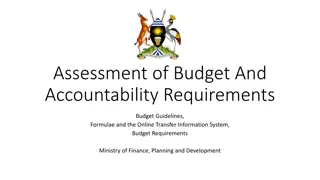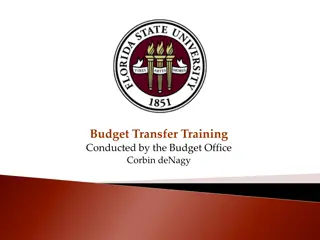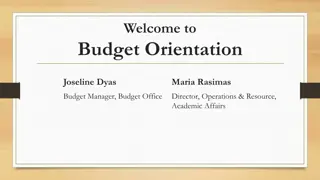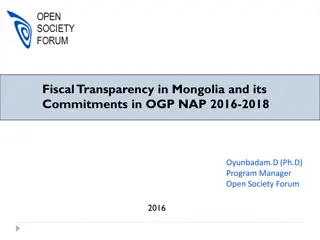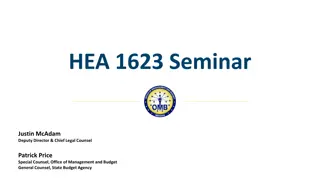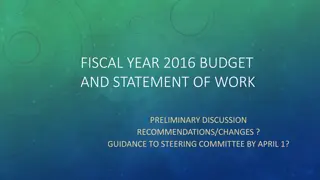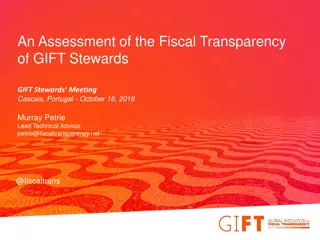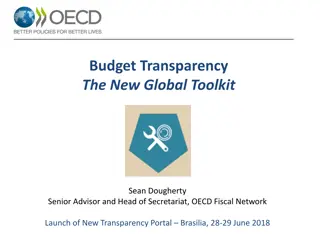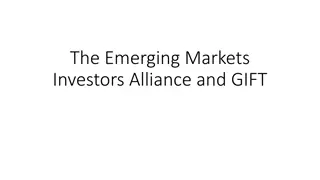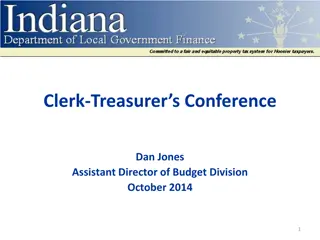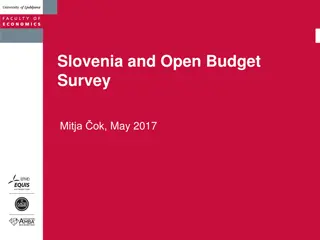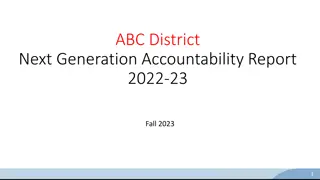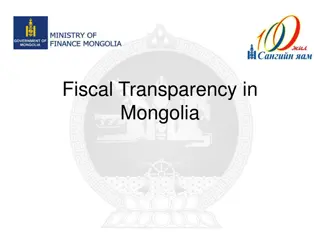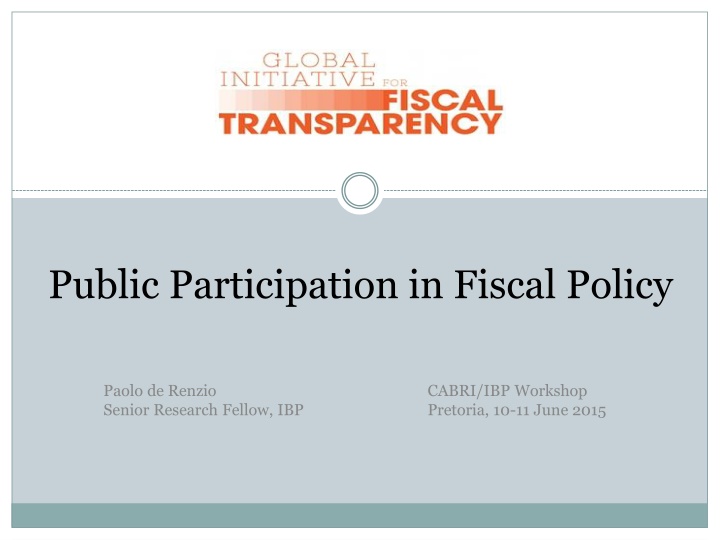
Promoting Fiscal Transparency and Public Participation in Governance
"Learn about GIFT, a multi-stakeholder network advancing fiscal transparency, participation, and accountability. Explore the importance of public participation in government decision-making for legitimacy, efficiency, and sustainability. Discover high-level principles on fiscal transparency and specific international norms for citizen engagement in fiscal policies."
Download Presentation

Please find below an Image/Link to download the presentation.
The content on the website is provided AS IS for your information and personal use only. It may not be sold, licensed, or shared on other websites without obtaining consent from the author. If you encounter any issues during the download, it is possible that the publisher has removed the file from their server.
You are allowed to download the files provided on this website for personal or commercial use, subject to the condition that they are used lawfully. All files are the property of their respective owners.
The content on the website is provided AS IS for your information and personal use only. It may not be sold, licensed, or shared on other websites without obtaining consent from the author.
E N D
Presentation Transcript
Public Participation in Fiscal Policy Paolo de Renzio Senior Research Fellow, IBP CABRI/IBP Workshop Pretoria, 10-11 June 2015
What is GIFT ? 2 GIFT is a multi-stakeholder action network to advance fiscal transparency, participation and accountability: Lead Stewards: Governments of Brazil & Philippines, International Budget Partnership, World Bank, IMF, Intl. Federation of Accountants GIFT promotes fiscal openness by: Developing a more coherent/comprehensive global architecture of norms Strengthening incentives for better practices (evidence research) Supporting peer-to-peer learning & technical assistance Harnessing information technologies & open data
Fiscal Openness & Public Participation 3 Fiscal openness includes transparency, participation & accountability in government decision-making over the mobilization, allocation & use of public resources Public participation is a critical mechanism through which government decision-making processes & public policies can be made more legitimate, efficient, equitable, accountable, and sustainable Citizens & civil society organizations are important agents of good governance, human security and sustainable development alongside the state and market
High Level Principles on Fiscal Transparency 4 Based on two fundamental rights principles: A public right to fiscal information (from UDHR Art. 19) (Principle 1) A right to participate directly in fiscal policy design and implementation (from ICCPR Art. 25) (Principle 10) Divided in two main parts: Access to Fiscal Information (Principles 1-4) The Governance of Fiscal Policy (Principles 5-10)
GIFT High Level Principle 10 5 10: Citizens should have the right and they, and all non-state actors, should have effective opportunities to participate directly in public debate and discussion over the design and implementation of fiscal policies.
Specific International Norms including PP 6 IMF Fiscal Transparency Code - Principle 2.3.3: The government provides citizens with an accessible summary of the implications of budget policies and an opportunity to participate in budget deliberations (good practice:citizens have formal voice in budget deliberations) OECD Principles of Good Budgetary Governance: Provide for an inclusive, participative & realistic debate on budgetary choices (facilitating the engagement of parliaments, citizens & civil society organizations in a realistic debate about key priorities, trade-offs, opportunity costs & value for money ) Updated Open Budget Survey 2012 (Section 5) measures participation across the budget cycle Public Expenditure & Financial Accountability Program: new pilot stand alone indicator on PP (drafted by GIFT)
Open Budget Survey 2012 Results on Public Participation (100 Countries) 7 Average public engagement score was only 19 out of 100 (for OGP member countries it was 29); Korea scored 91. In 51 countries, the executive is required to engage (directly) with the public during the budget process. In 32 countries, public testimony is heard by a legislative committee on the individual budgets of central government administrative units (i.e., ministries). In 42 countries, supreme audit institutions have mechanisms for engaging the public in formulating audit programs (by identifying programs that should be audited) or in conducting audit investigations (as respondents, witnesses, etc).
Short Normative Instrument on Participation Principles & Good Practices 8 Intended to: Complement other standards & norms Advance public participation by established good practices Guide and help governments & practitioners (and all stakeholders) Indicate to the public what they can expect And what they are entitled to Draws also on UN Conventions, Humanitarian Accountability Partnership Standard, Philippines Principles of DBM-CSO Engagement, the Open Government Guide, World Bank Social Accountability E- Guide, etc.
Scope of public participation in fiscal policy and budget making 9 Covers all fiscal policy and budget making activities: The annual budget cycle (8 documents) I. II. Fiscal policy reviews outside the annual budget cycle (revenue, tax, finances, asset, liability management) III. The design, production and delivery of public goods & services (including feedback, independent mechanisms) IV. The design & delivery of public investment projects (planning, apraisal, selection, implementation, audit)
The Principles of Public Participation 10 Openness about the purpose, process, and timelines Ensuring well-informed participation Ensuring meaningful participation Allowing sufficient time in the policy cycle for the public to provide inputs in each phase Ensuring inclusiveness & non-discrimination: pro-active use of multiple mechanisms Avoiding parallel systems that could undermine existing accountability structures 10
Some country examples of public participation: the Executive 11 Stage in budget or fiscal policy cycle Pre-budget Country examples Canada; Kenya; Korea; Philippines National planning Brazil New policies Public expenditure reviews Budget implementation: - Revenues - Public service delivery - Procurement - Evaluation Brazil; Canada; Croatia Netherlands; UK Countries in EITI Kenya; Mexico; South Africa Croatia; Kenya; Countries in CoST Canada; Korea
Some country examples of public participation: Legislature 12 Stage in legislative cycle Country examples Annual budget deliberation and enactment Canada; Croatia; Kenya; Korea; South Africa Spending Bills Annual Budget Review Canada; Croatia Croatia
Some country examples of public participation: Supreme Audit Institution 13 Stage in audit cycle Country examples Audit planning Korea; Mexico Conducting audits Review of audit reports Mexico; Philippines Croatia Audit follow-up Argentina; India (Andhra Pradesh); South Africa (Eastern Cape)
Good participation practices: Executive 14 Full disclosure of fiscal data in easily accessible formats Public engagement during budget preparation Participatory reviews of public spending Line ministry program, project & policy consultations Public participation in evaluations Mechanisms for client feedback & complaints against published service delivery standards (including client surveys on service delivery quality Public participation on management or governance bodies
Good participation practices: Legislature 15 Designate a unit /official responsible for management of public engagement in fiscal policy Plain language explanation of Bills Published forward agendas of Committee hearings, fiscal policy Bills Proactive publication of information on how to make a parliamentary submission Independent sources of technical support and advice on all aspects of macro-fiscal policy Public attendance and testimony at committee hearings reviewing proposed budgets and end of year reports including audit reports
Good participation practices: Audit Institutions 16 Designate a unit/official responsible for management of public engagement in auditing Publish the calendar for audits Mechanism for public input to audit work plan Hotlines Engage public during audits Participatory auditing Social audits Public monitoring of implementation of audit findings
Global Initiative for Fiscal Transparency 17 www.fiscaltransparency.net GIFT participation case studies and synthesis: http://fiscaltransparency.net/2014/11 /participation-case-studies-and- synthesis/




